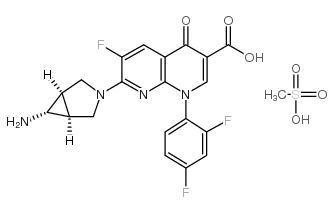147059-75-4
| Name | trovafloxacin mesylate |
|---|---|
| Synonyms |
Trovafloxacin mesylate,7-[(1α,5α,6α)-6-Amino-3-azabicyclo[3.1.0]hex-3-yl]-1-(2,4-difluorophenyl)-6-fluoro-1,4-dihydro-4-oxo-1,8-naphthyridine-3-carboxylicacidmesylate
Trovafloxacin Mesylate Trovafloxacin mesylate |
| Description | Trovafloxacin mesylate is a broad-spectrum quinolone antibiotic with potent activity against Gram-positive, Gram-negative and anaerobic organisms. Trovafloxacin mesylate blocks the DNA gyrase and topoisomerase IV activity. Trovafloxacin mesylate is also a potent, selective and orally active pannexin 1 channel (PANX1) inhibitor with an IC50 of 4 μM for PANX1 inward current. Trovafloxacin mesylate does not inhibit connexin 43 gap junction or PANX2. Trovafloxacin mesylate leads to dysregulated fragmentation of apoptotic cells by inhibiting PANX1[1][2][3]. |
|---|---|
| Related Catalog | |
| Target |
IC50: 4 μM (Pannexin 1 channel (PANX1))[2] Gram-positive, Gram-negative and anaerobic organisms[3] DNA gyrase[3] Topoisomerase IV[3] |
| In Vitro | Trovafloxacin (20 µM; 24 hours; HepG2 cells) and tumor necrosis factor (TNF; 4 ng/mL) incubation induces apoptosis and increases leakage of lactate dehydrogenase (LDH) in HepG2 cells[1]. Trovafloxacin (20 µM; 24 hours; HepG2 cells) and TNF (4 ng/mL) incubation increases expression of early NF-κB-related factors A20 and IκBα[1]. Trovafloxacin prolongs TNF-induced activation of MAPKs and IKKα/β activation in HepG2[1]. Trovafloxacin is a potent inhibitor of TO-PRO-3 uptake by apoptotic cells. Trovafloxacin also inhibits ATP release from apoptotic cells. Trovafloxacin does not inhibit caspase 3/7 activation, or caspase-mediated PANX1 cleavage during apoptosis[2]. Trovafloxacin is equally active against both penicillin-susceptible and -resistant pneumococci, with MICs of 0.06-0.25 mg/mL reported for more than 700 isolates. The MICs of Trovafloxacin at which 90% of isolates are inhibited for 55 isolates of pneumococci is 0.125 μg/mL[3]. Apoptosis Analysis[1] Cell Line: HepG2 cells Concentration: 20 µM Incubation Time: 24 hours Result: Showed a gradual increase of Annexin V-staining and an increased leakage of lactate dehydrogenase (LDH) at 24 h. RT-PCR[1] Cell Line: HepG2 cells Concentration: 20 µM Incubation Time: 24 hours Result: Caused a higher increase in the transcription of A20 and IκBα in HepG2 cells. |
| In Vivo | Trovafloxacin (150 mg/kg; oral administration; male C57BL/6 J mice) treatment disrupts TNF-induced p65 nuclear translocation. Trovafloxacin treatment increases expression of early NF-κB-related factors A20 and IκBα[1]. Trovafloxacin, when administered in combination with lipopolysaccharide (LPS) or TNF to mice induces severe liver toxicity associated with vast apoptotic areas in the liver, increased serum levels of alanine amino transferases (ALT) and pro-inflammatory cytokines[1]. Animal Model: Male C57BL/6 J mice (9-11-week-old) injected with recombinant murine TNF ion[1] Dosage: 150 mg/kg Administration: Oral administration; once Result: Showed a greater number of cells with increased nuclear/cytoplasmic p65 ratio in liver. |
| References |
| Boiling Point | 630.5ºC at 760mmHg |
|---|---|
| Melting Point | >250 °C (dec.) |
| Molecular Formula | C21H19F3N4O6S |
| Molecular Weight | 512.45900 |
| Flash Point | 335.1ºC |
| Exact Mass | 512.09800 |
| PSA | 164.20000 |
| LogP | 3.24460 |
| Vapour Pressure | 2.59E-24mmHg at 25°C |
| Symbol |


GHS05, GHS08 |
|---|---|
| Signal Word | Danger |
| Hazard Statements | H314-H361 |
| Precautionary Statements | P280-P305 + P351 + P338-P310 |
| Hazard Codes | C |
| Risk Phrases | 63-34 |
| Safety Phrases | 26-36-45 |
| RIDADR | UN 1759 8 / PGIII |
| RTECS | QN2791250 |
